This is the question at the heart of a NEW REPORT we publish today with survey data from those countries.
https://reutersinstitute.politics.ox.ac.uk/infodemic-how-people-six-countries-access-and-rate-news-and-information-about-coronavirus">https://reutersinstitute.politics.ox.ac.uk/infodemic...
2. News use is up, and most people in most countries are using either social media, search engines, video sites, and messaging applications (or combinations of these) to get news and information about coronavirus. Here are the figures for every country covered by the report
3. News organisations are the most widely used source of information about #COVID19 in almost every country. % for news organisations are higher in  https://abs.twimg.com/emoji/v2/... draggable="false" alt="🇪🇸" title="Flag of Spain" aria-label="Emoji: Flag of Spain">
https://abs.twimg.com/emoji/v2/... draggable="false" alt="🇪🇸" title="Flag of Spain" aria-label="Emoji: Flag of Spain"> https://abs.twimg.com/emoji/v2/... draggable="false" alt="🇦🇷" title="Flag of Argentina" aria-label="Emoji: Flag of Argentina">
https://abs.twimg.com/emoji/v2/... draggable="false" alt="🇦🇷" title="Flag of Argentina" aria-label="Emoji: Flag of Argentina"> https://abs.twimg.com/emoji/v2/... draggable="false" alt="🇰🇷" title="Flag of South Korea" aria-label="Emoji: Flag of South Korea">
https://abs.twimg.com/emoji/v2/... draggable="false" alt="🇰🇷" title="Flag of South Korea" aria-label="Emoji: Flag of South Korea">
However, those with low levels of formal education are much less likely to say that they rely on news orgs
However, those with low levels of formal education are much less likely to say that they rely on news orgs
4. Search, video and social platforms are widely used to access #COVID19 information. Here are some of the most popular by country. Google Search is widely used in  https://abs.twimg.com/emoji/v2/... draggable="false" alt="🇪🇸" title="Flag of Spain" aria-label="Emoji: Flag of Spain">
https://abs.twimg.com/emoji/v2/... draggable="false" alt="🇪🇸" title="Flag of Spain" aria-label="Emoji: Flag of Spain"> https://abs.twimg.com/emoji/v2/... draggable="false" alt="🇦🇷" title="Flag of Argentina" aria-label="Emoji: Flag of Argentina">. Naver is popular in
https://abs.twimg.com/emoji/v2/... draggable="false" alt="🇦🇷" title="Flag of Argentina" aria-label="Emoji: Flag of Argentina">. Naver is popular in  https://abs.twimg.com/emoji/v2/... draggable="false" alt="🇰🇷" title="Flag of South Korea" aria-label="Emoji: Flag of South Korea">. Younger & less educated people, who tend to use news less, tend to use platforms more
https://abs.twimg.com/emoji/v2/... draggable="false" alt="🇰🇷" title="Flag of South Korea" aria-label="Emoji: Flag of South Korea">. Younger & less educated people, who tend to use news less, tend to use platforms more
5. Private groups in social platforms and messaging apps are widely used to discuss #COVID19. These groups primarily include family and friends/colleagues, not strangers. Here are the figures for every country in the report. The % for WhatsApp in  https://abs.twimg.com/emoji/v2/... draggable="false" alt="🇦🇷" title="Flag of Argentina" aria-label="Emoji: Flag of Argentina">
https://abs.twimg.com/emoji/v2/... draggable="false" alt="🇦🇷" title="Flag of Argentina" aria-label="Emoji: Flag of Argentina"> https://abs.twimg.com/emoji/v2/... draggable="false" alt="🇪🇸" title="Flag of Spain" aria-label="Emoji: Flag of Spain"> is very high
https://abs.twimg.com/emoji/v2/... draggable="false" alt="🇪🇸" title="Flag of Spain" aria-label="Emoji: Flag of Spain"> is very high
6. Scientists & experts are highly & broadly trusted on #COVID19. News organisations are rated as relatively trustworthy by a majority. % is a bit smaller in  https://abs.twimg.com/emoji/v2/... draggable="false" alt="🇺🇸" title="Flag of United States" aria-label="Emoji: Flag of United States">
https://abs.twimg.com/emoji/v2/... draggable="false" alt="🇺🇸" title="Flag of United States" aria-label="Emoji: Flag of United States"> https://abs.twimg.com/emoji/v2/... draggable="false" alt="🇪🇸" title="Flag of Spain" aria-label="Emoji: Flag of Spain">. These countries are also the only ones where the national government is not trusted by a majority of the population
https://abs.twimg.com/emoji/v2/... draggable="false" alt="🇪🇸" title="Flag of Spain" aria-label="Emoji: Flag of Spain">. These countries are also the only ones where the national government is not trusted by a majority of the population
7. Top-line figures can obscure pronounced social and political differences in trust. People with lower levels of formal education often trust news less. And especially in the US, people of different political persuasions rate news & government very differently. Look at the chart
8. Most respondents rate platforms as less trustworthy than experts, health authorities & news orgs. Here is the "trust gap" between news orgs. and platforms, on average:
 https://abs.twimg.com/emoji/v2/... draggable="false" alt="📱" title="Mobile phone" aria-label="Emoji: Mobile phone">34 points for messaging apps
https://abs.twimg.com/emoji/v2/... draggable="false" alt="📱" title="Mobile phone" aria-label="Emoji: Mobile phone">34 points for messaging apps
 https://abs.twimg.com/emoji/v2/... draggable="false" alt="🐦" title="Bird" aria-label="Emoji: Bird">33 for social
https://abs.twimg.com/emoji/v2/... draggable="false" alt="🐦" title="Bird" aria-label="Emoji: Bird">33 for social
 https://abs.twimg.com/emoji/v2/... draggable="false" alt="🎥" title="Movie camera" aria-label="Emoji: Movie camera">30 for video sites
https://abs.twimg.com/emoji/v2/... draggable="false" alt="🎥" title="Movie camera" aria-label="Emoji: Movie camera">30 for video sites
 https://abs.twimg.com/emoji/v2/... draggable="false" alt="🔍" title="Left-pointing magnifying glass" aria-label="Emoji: Left-pointing magnifying glass">14 for search
https://abs.twimg.com/emoji/v2/... draggable="false" alt="🔍" title="Left-pointing magnifying glass" aria-label="Emoji: Left-pointing magnifying glass">14 for search
Figures by country here
Figures by country here
9. Concern about misinformation is focused on & #39;bottom-up& #39; false or misleading content spread by ordinary people whom respondents do not know personally. However, respondents in  https://abs.twimg.com/emoji/v2/... draggable="false" alt="🇰🇷" title="Flag of South Korea" aria-label="Emoji: Flag of South Korea">
https://abs.twimg.com/emoji/v2/... draggable="false" alt="🇰🇷" title="Flag of South Korea" aria-label="Emoji: Flag of South Korea"> https://abs.twimg.com/emoji/v2/... draggable="false" alt="🇺🇸" title="Flag of United States" aria-label="Emoji: Flag of United States">
https://abs.twimg.com/emoji/v2/... draggable="false" alt="🇺🇸" title="Flag of United States" aria-label="Emoji: Flag of United States"> https://abs.twimg.com/emoji/v2/... draggable="false" alt="🇪🇸" title="Flag of Spain" aria-label="Emoji: Flag of Spain"> say individual politicians generate large volumes of top-down misinformation
https://abs.twimg.com/emoji/v2/... draggable="false" alt="🇪🇸" title="Flag of Spain" aria-label="Emoji: Flag of Spain"> say individual politicians generate large volumes of top-down misinformation
10. Among platforms, concern is focused on social media and messaging apps, where on average about a third of respondents say they have seen a lot or a great deal of false or misleading information in the last week.
% for social and messaging apps are especially high in https://abs.twimg.com/emoji/v2/... draggable="false" alt="🇦🇷" title="Flag of Argentina" aria-label="Emoji: Flag of Argentina">
https://abs.twimg.com/emoji/v2/... draggable="false" alt="🇦🇷" title="Flag of Argentina" aria-label="Emoji: Flag of Argentina"> https://abs.twimg.com/emoji/v2/... draggable="false" alt="🇪🇸" title="Flag of Spain" aria-label="Emoji: Flag of Spain">
https://abs.twimg.com/emoji/v2/... draggable="false" alt="🇪🇸" title="Flag of Spain" aria-label="Emoji: Flag of Spain">
% for social and messaging apps are especially high in
11. Overall, a large majority of our respondents say they feel news media have helped them understand the crisis and have explained how they can respond to it.
 https://abs.twimg.com/emoji/v2/... draggable="false" alt="🏛" title="Classical building" aria-label="Emoji: Classical building">Governments, on average, rated less well than news organisations in helping people understand the crisis
https://abs.twimg.com/emoji/v2/... draggable="false" alt="🏛" title="Classical building" aria-label="Emoji: Classical building">Governments, on average, rated less well than news organisations in helping people understand the crisis
12. Most people do relatively well when asked a series of factual questions about coronavirus, with a clear majority answering more than half the questions correctly. Using news orgs as source of info is associated with higher knowledge in most countries (not in  https://abs.twimg.com/emoji/v2/... draggable="false" alt="🇪🇸" title="Flag of Spain" aria-label="Emoji: Flag of Spain">
https://abs.twimg.com/emoji/v2/... draggable="false" alt="🇪🇸" title="Flag of Spain" aria-label="Emoji: Flag of Spain"> https://abs.twimg.com/emoji/v2/... draggable="false" alt="🇦🇷" title="Flag of Argentina" aria-label="Emoji: Flag of Argentina">)
https://abs.twimg.com/emoji/v2/... draggable="false" alt="🇦🇷" title="Flag of Argentina" aria-label="Emoji: Flag of Argentina">)
13. The report, authored by @rasmus_kleis @dragz @nicnewman @jsbrennen & @pnhoward, is based on survey data collected by @YouGov from 31 March to 7 April 2020 across  https://abs.twimg.com/emoji/v2/... draggable="false" alt="🇦🇷" title="Flag of Argentina" aria-label="Emoji: Flag of Argentina">
https://abs.twimg.com/emoji/v2/... draggable="false" alt="🇦🇷" title="Flag of Argentina" aria-label="Emoji: Flag of Argentina"> https://abs.twimg.com/emoji/v2/... draggable="false" alt="🇪🇸" title="Flag of Spain" aria-label="Emoji: Flag of Spain">
https://abs.twimg.com/emoji/v2/... draggable="false" alt="🇪🇸" title="Flag of Spain" aria-label="Emoji: Flag of Spain"> https://abs.twimg.com/emoji/v2/... draggable="false" alt="🇺🇸" title="Flag of United States" aria-label="Emoji: Flag of United States">
https://abs.twimg.com/emoji/v2/... draggable="false" alt="🇺🇸" title="Flag of United States" aria-label="Emoji: Flag of United States"> https://abs.twimg.com/emoji/v2/... draggable="false" alt="🇩🇪" title="Flag of Germany" aria-label="Emoji: Flag of Germany">
https://abs.twimg.com/emoji/v2/... draggable="false" alt="🇩🇪" title="Flag of Germany" aria-label="Emoji: Flag of Germany"> https://abs.twimg.com/emoji/v2/... draggable="false" alt="🇰🇷" title="Flag of South Korea" aria-label="Emoji: Flag of South Korea">
https://abs.twimg.com/emoji/v2/... draggable="false" alt="🇰🇷" title="Flag of South Korea" aria-label="Emoji: Flag of South Korea"> https://abs.twimg.com/emoji/v2/... draggable="false" alt="🇬🇧" title="Flag of United Kingdom" aria-label="Emoji: Flag of United Kingdom">.
https://abs.twimg.com/emoji/v2/... draggable="false" alt="🇬🇧" title="Flag of United Kingdom" aria-label="Emoji: Flag of United Kingdom">.
 https://abs.twimg.com/emoji/v2/... draggable="false" alt="📑" title="Bookmark tabs" aria-label="Emoji: Bookmark tabs">Download a PDF version here
https://abs.twimg.com/emoji/v2/... draggable="false" alt="📑" title="Bookmark tabs" aria-label="Emoji: Bookmark tabs">Download a PDF version here
https://reutersinstitute.politics.ox.ac.uk/sites/default/files/2020-04/Navigating%20the%20Coronavirus%20Infodemic%20FINAL.pdf
https://reutersinstitute.politics.ox.ac.uk/sites/def... class="Emoji" style="height:16px;" src=" https://abs.twimg.com/emoji/v2/... draggable="false" alt="📱" title="Mobile phone" aria-label="Emoji: Mobile phone">Read it here https://reutersinstitute.politics.ox.ac.uk/infodemic-how-people-six-countries-access-and-rate-news-and-information-about-coronavirus">https://reutersinstitute.politics.ox.ac.uk/infodemic...
https://reutersinstitute.politics.ox.ac.uk/sites/default/files/2020-04/Navigating%20the%20Coronavirus%20Infodemic%20FINAL.pdf

 Read on Twitter
Read on Twitter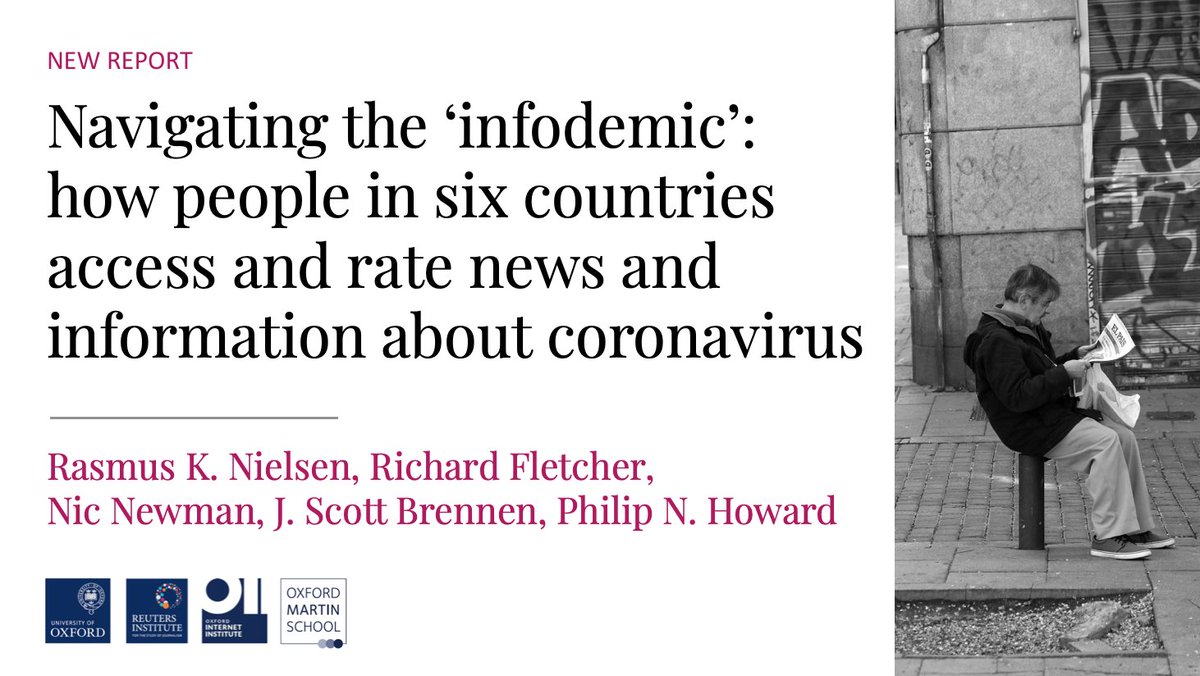 How do people in https://abs.twimg.com/emoji/v2/... draggable="false" alt="🇬🇧" title="Flag of United Kingdom" aria-label="Emoji: Flag of United Kingdom">https://abs.twimg.com/emoji/v2/... draggable="false" alt="🇺🇸" title="Flag of United States" aria-label="Emoji: Flag of United States">https://abs.twimg.com/emoji/v2/... draggable="false" alt="🇩🇪" title="Flag of Germany" aria-label="Emoji: Flag of Germany">https://abs.twimg.com/emoji/v2/... draggable="false" alt="🇪🇸" title="Flag of Spain" aria-label="Emoji: Flag of Spain">https://abs.twimg.com/emoji/v2/... draggable="false" alt="🇦🇷" title="Flag of Argentina" aria-label="Emoji: Flag of Argentina">https://abs.twimg.com/emoji/v2/... draggable="false" alt="🇰🇷" title="Flag of South Korea" aria-label="Emoji: Flag of South Korea"> access and rate news and information around #COVID19? This is the question at the heart of a NEW REPORT we publish today with survey data from those countries. https://abs.twimg.com/emoji/v2/... draggable="false" alt="🧶" title="Yarn" aria-label="Emoji: Yarn">Key findings in this thread https://abs.twimg.com/emoji/v2/... draggable="false" alt="📱" title="Mobile phone" aria-label="Emoji: Mobile phone">Full report in this link https://reutersinstitute.politics.ox.ac.uk/infodemic..." title="https://abs.twimg.com/emoji/v2/... draggable="false" alt="📌" title="Pushpin" aria-label="Emoji: Pushpin"> How do people in https://abs.twimg.com/emoji/v2/... draggable="false" alt="🇬🇧" title="Flag of United Kingdom" aria-label="Emoji: Flag of United Kingdom">https://abs.twimg.com/emoji/v2/... draggable="false" alt="🇺🇸" title="Flag of United States" aria-label="Emoji: Flag of United States">https://abs.twimg.com/emoji/v2/... draggable="false" alt="🇩🇪" title="Flag of Germany" aria-label="Emoji: Flag of Germany">https://abs.twimg.com/emoji/v2/... draggable="false" alt="🇪🇸" title="Flag of Spain" aria-label="Emoji: Flag of Spain">https://abs.twimg.com/emoji/v2/... draggable="false" alt="🇦🇷" title="Flag of Argentina" aria-label="Emoji: Flag of Argentina">https://abs.twimg.com/emoji/v2/... draggable="false" alt="🇰🇷" title="Flag of South Korea" aria-label="Emoji: Flag of South Korea"> access and rate news and information around #COVID19? This is the question at the heart of a NEW REPORT we publish today with survey data from those countries. https://abs.twimg.com/emoji/v2/... draggable="false" alt="🧶" title="Yarn" aria-label="Emoji: Yarn">Key findings in this thread https://abs.twimg.com/emoji/v2/... draggable="false" alt="📱" title="Mobile phone" aria-label="Emoji: Mobile phone">Full report in this link https://reutersinstitute.politics.ox.ac.uk/infodemic..." class="img-responsive" style="max-width:100%;"/>
How do people in https://abs.twimg.com/emoji/v2/... draggable="false" alt="🇬🇧" title="Flag of United Kingdom" aria-label="Emoji: Flag of United Kingdom">https://abs.twimg.com/emoji/v2/... draggable="false" alt="🇺🇸" title="Flag of United States" aria-label="Emoji: Flag of United States">https://abs.twimg.com/emoji/v2/... draggable="false" alt="🇩🇪" title="Flag of Germany" aria-label="Emoji: Flag of Germany">https://abs.twimg.com/emoji/v2/... draggable="false" alt="🇪🇸" title="Flag of Spain" aria-label="Emoji: Flag of Spain">https://abs.twimg.com/emoji/v2/... draggable="false" alt="🇦🇷" title="Flag of Argentina" aria-label="Emoji: Flag of Argentina">https://abs.twimg.com/emoji/v2/... draggable="false" alt="🇰🇷" title="Flag of South Korea" aria-label="Emoji: Flag of South Korea"> access and rate news and information around #COVID19? This is the question at the heart of a NEW REPORT we publish today with survey data from those countries. https://abs.twimg.com/emoji/v2/... draggable="false" alt="🧶" title="Yarn" aria-label="Emoji: Yarn">Key findings in this thread https://abs.twimg.com/emoji/v2/... draggable="false" alt="📱" title="Mobile phone" aria-label="Emoji: Mobile phone">Full report in this link https://reutersinstitute.politics.ox.ac.uk/infodemic..." title="https://abs.twimg.com/emoji/v2/... draggable="false" alt="📌" title="Pushpin" aria-label="Emoji: Pushpin"> How do people in https://abs.twimg.com/emoji/v2/... draggable="false" alt="🇬🇧" title="Flag of United Kingdom" aria-label="Emoji: Flag of United Kingdom">https://abs.twimg.com/emoji/v2/... draggable="false" alt="🇺🇸" title="Flag of United States" aria-label="Emoji: Flag of United States">https://abs.twimg.com/emoji/v2/... draggable="false" alt="🇩🇪" title="Flag of Germany" aria-label="Emoji: Flag of Germany">https://abs.twimg.com/emoji/v2/... draggable="false" alt="🇪🇸" title="Flag of Spain" aria-label="Emoji: Flag of Spain">https://abs.twimg.com/emoji/v2/... draggable="false" alt="🇦🇷" title="Flag of Argentina" aria-label="Emoji: Flag of Argentina">https://abs.twimg.com/emoji/v2/... draggable="false" alt="🇰🇷" title="Flag of South Korea" aria-label="Emoji: Flag of South Korea"> access and rate news and information around #COVID19? This is the question at the heart of a NEW REPORT we publish today with survey data from those countries. https://abs.twimg.com/emoji/v2/... draggable="false" alt="🧶" title="Yarn" aria-label="Emoji: Yarn">Key findings in this thread https://abs.twimg.com/emoji/v2/... draggable="false" alt="📱" title="Mobile phone" aria-label="Emoji: Mobile phone">Full report in this link https://reutersinstitute.politics.ox.ac.uk/infodemic..." class="img-responsive" style="max-width:100%;"/>

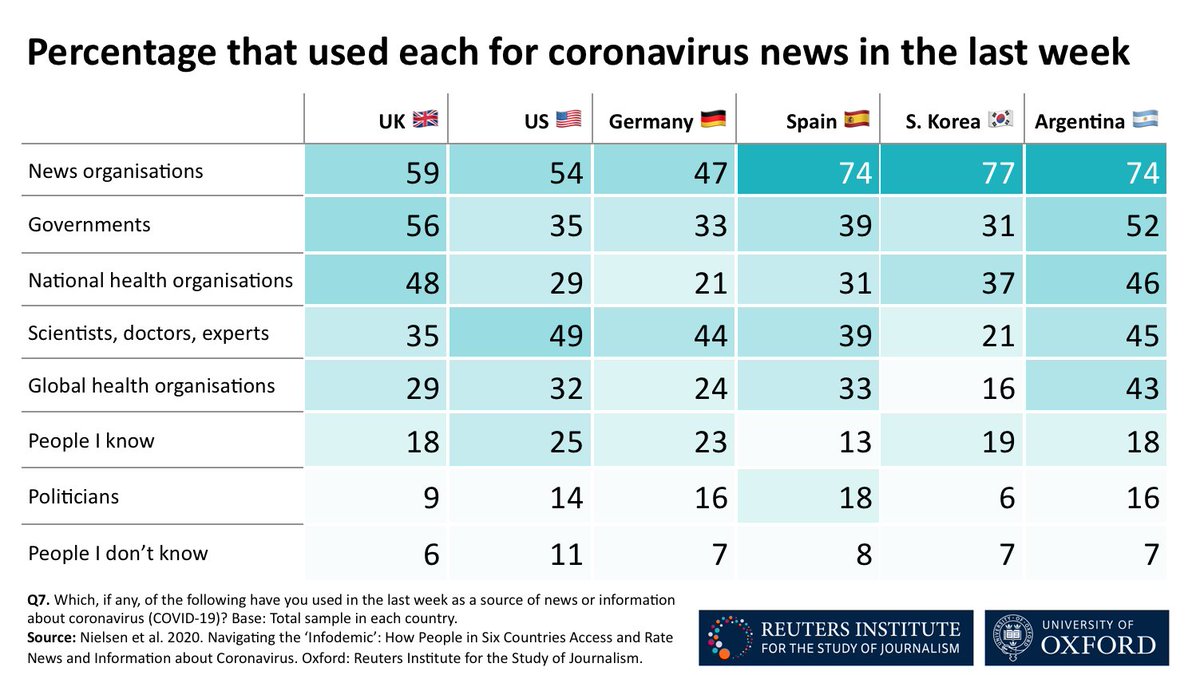 https://abs.twimg.com/emoji/v2/... draggable="false" alt="🇦🇷" title="Flag of Argentina" aria-label="Emoji: Flag of Argentina">https://abs.twimg.com/emoji/v2/... draggable="false" alt="🇰🇷" title="Flag of South Korea" aria-label="Emoji: Flag of South Korea"> However, those with low levels of formal education are much less likely to say that they rely on news orgs" title="3. News organisations are the most widely used source of information about #COVID19 in almost every country. % for news organisations are higher in https://abs.twimg.com/emoji/v2/... draggable="false" alt="🇪🇸" title="Flag of Spain" aria-label="Emoji: Flag of Spain">https://abs.twimg.com/emoji/v2/... draggable="false" alt="🇦🇷" title="Flag of Argentina" aria-label="Emoji: Flag of Argentina">https://abs.twimg.com/emoji/v2/... draggable="false" alt="🇰🇷" title="Flag of South Korea" aria-label="Emoji: Flag of South Korea"> However, those with low levels of formal education are much less likely to say that they rely on news orgs" class="img-responsive" style="max-width:100%;"/>
https://abs.twimg.com/emoji/v2/... draggable="false" alt="🇦🇷" title="Flag of Argentina" aria-label="Emoji: Flag of Argentina">https://abs.twimg.com/emoji/v2/... draggable="false" alt="🇰🇷" title="Flag of South Korea" aria-label="Emoji: Flag of South Korea"> However, those with low levels of formal education are much less likely to say that they rely on news orgs" title="3. News organisations are the most widely used source of information about #COVID19 in almost every country. % for news organisations are higher in https://abs.twimg.com/emoji/v2/... draggable="false" alt="🇪🇸" title="Flag of Spain" aria-label="Emoji: Flag of Spain">https://abs.twimg.com/emoji/v2/... draggable="false" alt="🇦🇷" title="Flag of Argentina" aria-label="Emoji: Flag of Argentina">https://abs.twimg.com/emoji/v2/... draggable="false" alt="🇰🇷" title="Flag of South Korea" aria-label="Emoji: Flag of South Korea"> However, those with low levels of formal education are much less likely to say that they rely on news orgs" class="img-responsive" style="max-width:100%;"/>
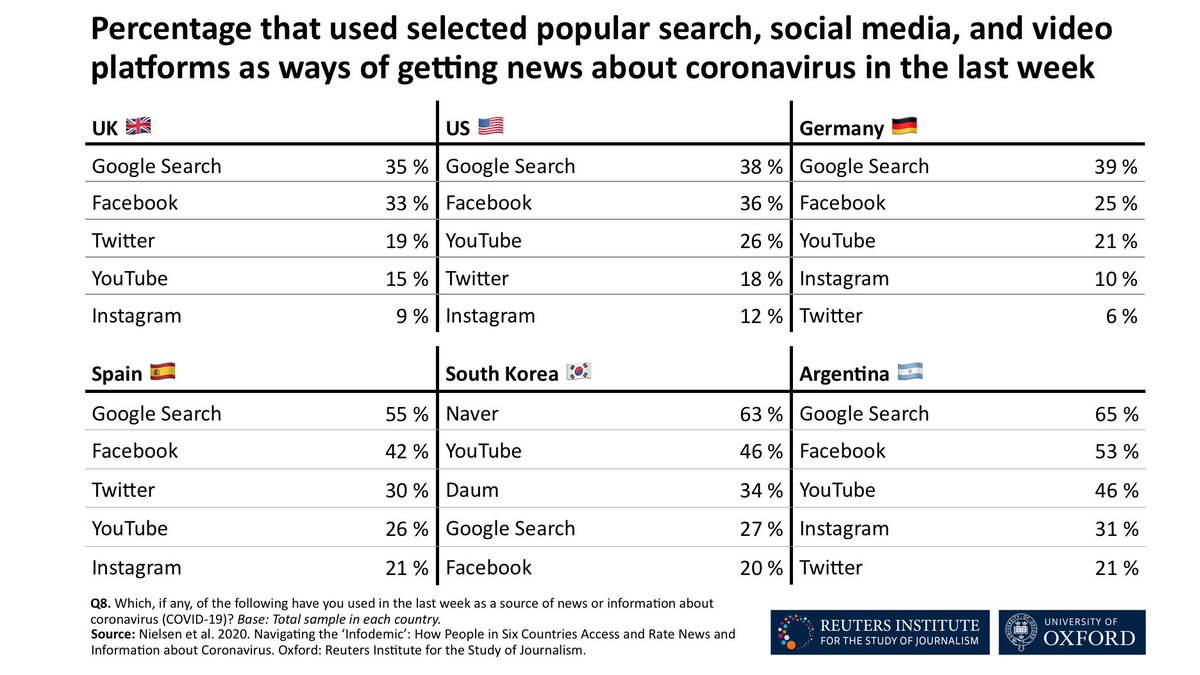 https://abs.twimg.com/emoji/v2/... draggable="false" alt="🇦🇷" title="Flag of Argentina" aria-label="Emoji: Flag of Argentina">. Naver is popular in https://abs.twimg.com/emoji/v2/... draggable="false" alt="🇰🇷" title="Flag of South Korea" aria-label="Emoji: Flag of South Korea">. Younger & less educated people, who tend to use news less, tend to use platforms more" title="4. Search, video and social platforms are widely used to access #COVID19 information. Here are some of the most popular by country. Google Search is widely used in https://abs.twimg.com/emoji/v2/... draggable="false" alt="🇪🇸" title="Flag of Spain" aria-label="Emoji: Flag of Spain">https://abs.twimg.com/emoji/v2/... draggable="false" alt="🇦🇷" title="Flag of Argentina" aria-label="Emoji: Flag of Argentina">. Naver is popular in https://abs.twimg.com/emoji/v2/... draggable="false" alt="🇰🇷" title="Flag of South Korea" aria-label="Emoji: Flag of South Korea">. Younger & less educated people, who tend to use news less, tend to use platforms more" class="img-responsive" style="max-width:100%;"/>
https://abs.twimg.com/emoji/v2/... draggable="false" alt="🇦🇷" title="Flag of Argentina" aria-label="Emoji: Flag of Argentina">. Naver is popular in https://abs.twimg.com/emoji/v2/... draggable="false" alt="🇰🇷" title="Flag of South Korea" aria-label="Emoji: Flag of South Korea">. Younger & less educated people, who tend to use news less, tend to use platforms more" title="4. Search, video and social platforms are widely used to access #COVID19 information. Here are some of the most popular by country. Google Search is widely used in https://abs.twimg.com/emoji/v2/... draggable="false" alt="🇪🇸" title="Flag of Spain" aria-label="Emoji: Flag of Spain">https://abs.twimg.com/emoji/v2/... draggable="false" alt="🇦🇷" title="Flag of Argentina" aria-label="Emoji: Flag of Argentina">. Naver is popular in https://abs.twimg.com/emoji/v2/... draggable="false" alt="🇰🇷" title="Flag of South Korea" aria-label="Emoji: Flag of South Korea">. Younger & less educated people, who tend to use news less, tend to use platforms more" class="img-responsive" style="max-width:100%;"/>
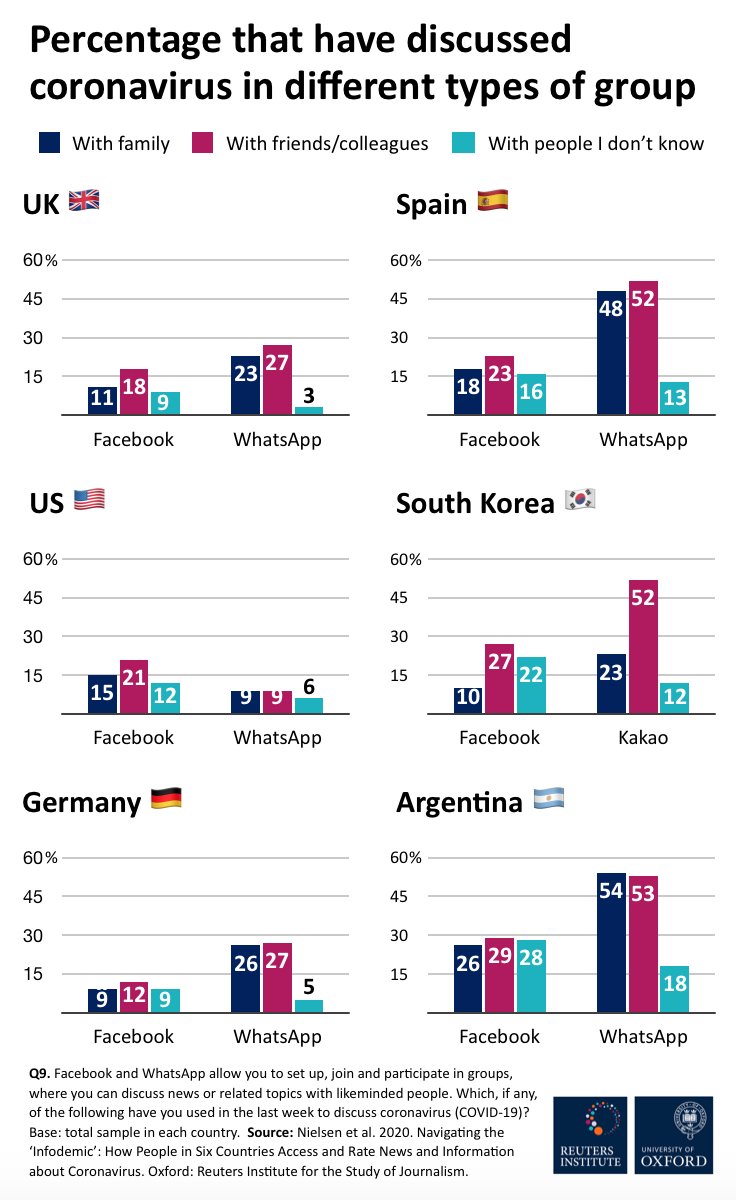 https://abs.twimg.com/emoji/v2/... draggable="false" alt="🇪🇸" title="Flag of Spain" aria-label="Emoji: Flag of Spain"> is very high" title="5. Private groups in social platforms and messaging apps are widely used to discuss #COVID19. These groups primarily include family and friends/colleagues, not strangers. Here are the figures for every country in the report. The % for WhatsApp in https://abs.twimg.com/emoji/v2/... draggable="false" alt="🇦🇷" title="Flag of Argentina" aria-label="Emoji: Flag of Argentina">https://abs.twimg.com/emoji/v2/... draggable="false" alt="🇪🇸" title="Flag of Spain" aria-label="Emoji: Flag of Spain"> is very high" class="img-responsive" style="max-width:100%;"/>
https://abs.twimg.com/emoji/v2/... draggable="false" alt="🇪🇸" title="Flag of Spain" aria-label="Emoji: Flag of Spain"> is very high" title="5. Private groups in social platforms and messaging apps are widely used to discuss #COVID19. These groups primarily include family and friends/colleagues, not strangers. Here are the figures for every country in the report. The % for WhatsApp in https://abs.twimg.com/emoji/v2/... draggable="false" alt="🇦🇷" title="Flag of Argentina" aria-label="Emoji: Flag of Argentina">https://abs.twimg.com/emoji/v2/... draggable="false" alt="🇪🇸" title="Flag of Spain" aria-label="Emoji: Flag of Spain"> is very high" class="img-responsive" style="max-width:100%;"/>
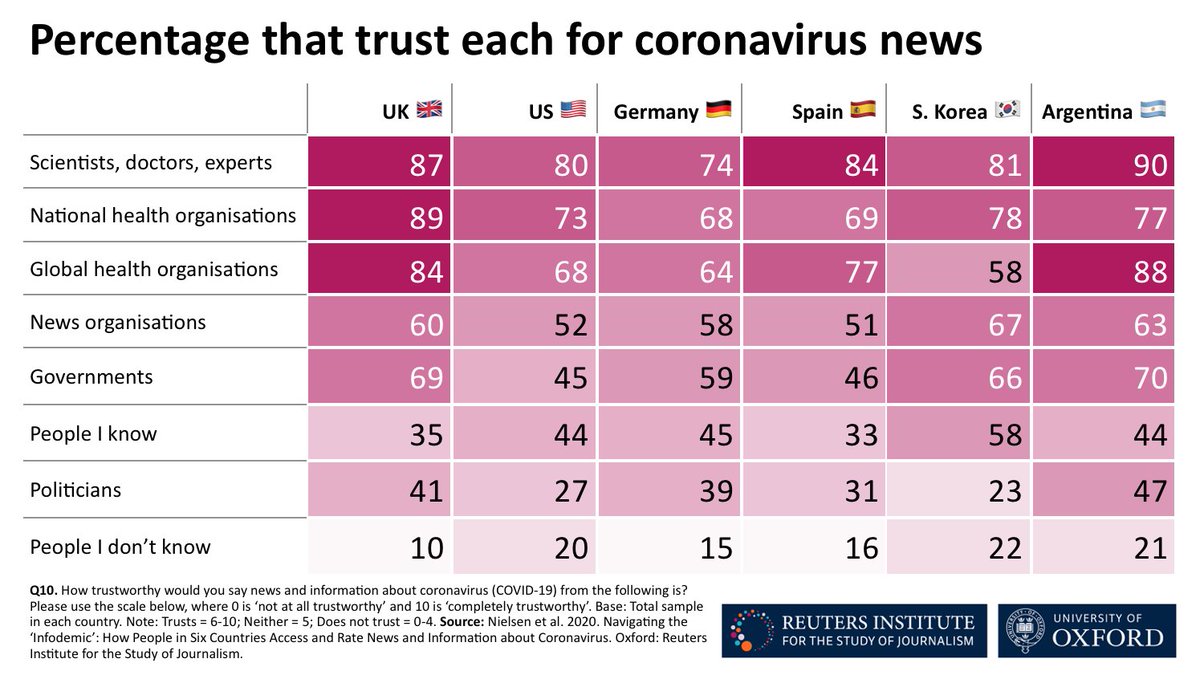 https://abs.twimg.com/emoji/v2/... draggable="false" alt="🇪🇸" title="Flag of Spain" aria-label="Emoji: Flag of Spain">. These countries are also the only ones where the national government is not trusted by a majority of the population" title="6. Scientists & experts are highly & broadly trusted on #COVID19. News organisations are rated as relatively trustworthy by a majority. % is a bit smaller in https://abs.twimg.com/emoji/v2/... draggable="false" alt="🇺🇸" title="Flag of United States" aria-label="Emoji: Flag of United States">https://abs.twimg.com/emoji/v2/... draggable="false" alt="🇪🇸" title="Flag of Spain" aria-label="Emoji: Flag of Spain">. These countries are also the only ones where the national government is not trusted by a majority of the population" class="img-responsive" style="max-width:100%;"/>
https://abs.twimg.com/emoji/v2/... draggable="false" alt="🇪🇸" title="Flag of Spain" aria-label="Emoji: Flag of Spain">. These countries are also the only ones where the national government is not trusted by a majority of the population" title="6. Scientists & experts are highly & broadly trusted on #COVID19. News organisations are rated as relatively trustworthy by a majority. % is a bit smaller in https://abs.twimg.com/emoji/v2/... draggable="false" alt="🇺🇸" title="Flag of United States" aria-label="Emoji: Flag of United States">https://abs.twimg.com/emoji/v2/... draggable="false" alt="🇪🇸" title="Flag of Spain" aria-label="Emoji: Flag of Spain">. These countries are also the only ones where the national government is not trusted by a majority of the population" class="img-responsive" style="max-width:100%;"/>
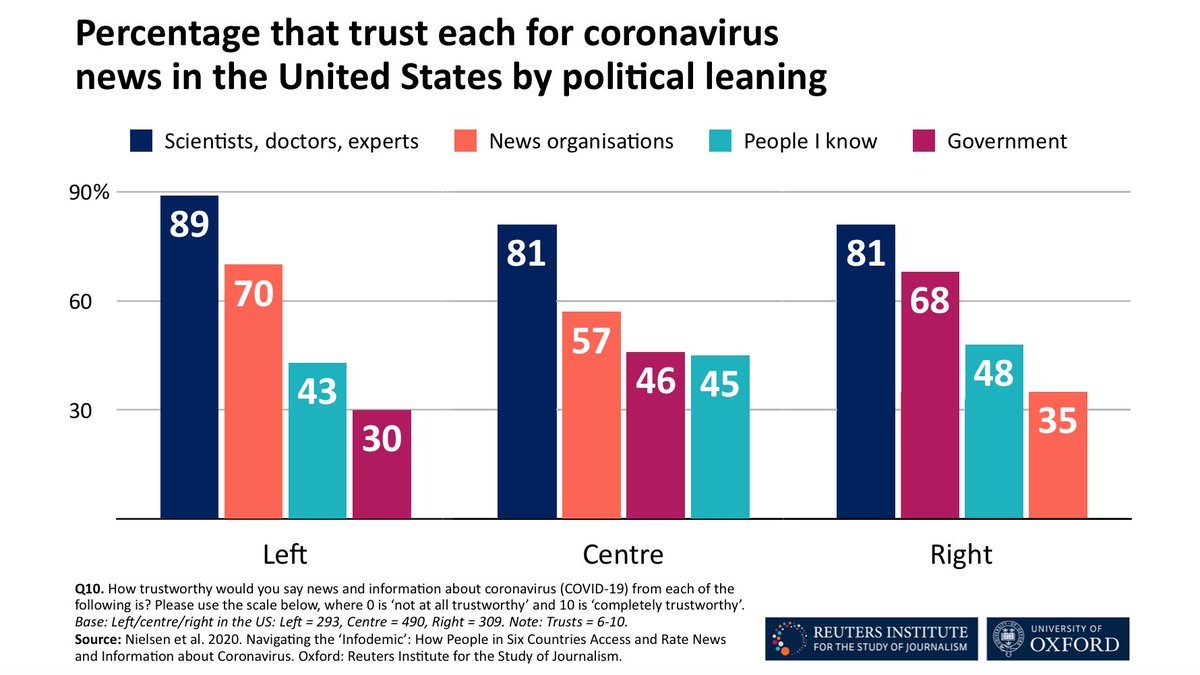
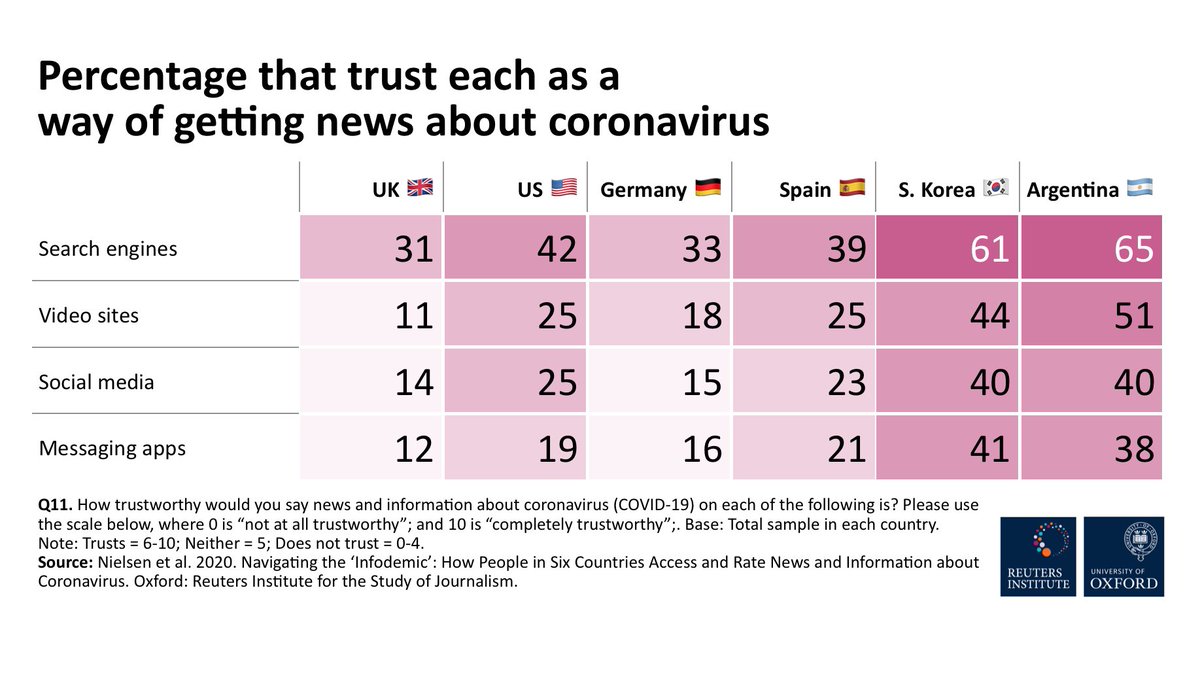 34 points for messaging appshttps://abs.twimg.com/emoji/v2/... draggable="false" alt="🐦" title="Bird" aria-label="Emoji: Bird">33 for socialhttps://abs.twimg.com/emoji/v2/... draggable="false" alt="🎥" title="Movie camera" aria-label="Emoji: Movie camera">30 for video siteshttps://abs.twimg.com/emoji/v2/... draggable="false" alt="🔍" title="Left-pointing magnifying glass" aria-label="Emoji: Left-pointing magnifying glass">14 for searchFigures by country here" title="8. Most respondents rate platforms as less trustworthy than experts, health authorities & news orgs. Here is the "trust gap" between news orgs. and platforms, on average:https://abs.twimg.com/emoji/v2/... draggable="false" alt="📱" title="Mobile phone" aria-label="Emoji: Mobile phone">34 points for messaging appshttps://abs.twimg.com/emoji/v2/... draggable="false" alt="🐦" title="Bird" aria-label="Emoji: Bird">33 for socialhttps://abs.twimg.com/emoji/v2/... draggable="false" alt="🎥" title="Movie camera" aria-label="Emoji: Movie camera">30 for video siteshttps://abs.twimg.com/emoji/v2/... draggable="false" alt="🔍" title="Left-pointing magnifying glass" aria-label="Emoji: Left-pointing magnifying glass">14 for searchFigures by country here" class="img-responsive" style="max-width:100%;"/>
34 points for messaging appshttps://abs.twimg.com/emoji/v2/... draggable="false" alt="🐦" title="Bird" aria-label="Emoji: Bird">33 for socialhttps://abs.twimg.com/emoji/v2/... draggable="false" alt="🎥" title="Movie camera" aria-label="Emoji: Movie camera">30 for video siteshttps://abs.twimg.com/emoji/v2/... draggable="false" alt="🔍" title="Left-pointing magnifying glass" aria-label="Emoji: Left-pointing magnifying glass">14 for searchFigures by country here" title="8. Most respondents rate platforms as less trustworthy than experts, health authorities & news orgs. Here is the "trust gap" between news orgs. and platforms, on average:https://abs.twimg.com/emoji/v2/... draggable="false" alt="📱" title="Mobile phone" aria-label="Emoji: Mobile phone">34 points for messaging appshttps://abs.twimg.com/emoji/v2/... draggable="false" alt="🐦" title="Bird" aria-label="Emoji: Bird">33 for socialhttps://abs.twimg.com/emoji/v2/... draggable="false" alt="🎥" title="Movie camera" aria-label="Emoji: Movie camera">30 for video siteshttps://abs.twimg.com/emoji/v2/... draggable="false" alt="🔍" title="Left-pointing magnifying glass" aria-label="Emoji: Left-pointing magnifying glass">14 for searchFigures by country here" class="img-responsive" style="max-width:100%;"/>
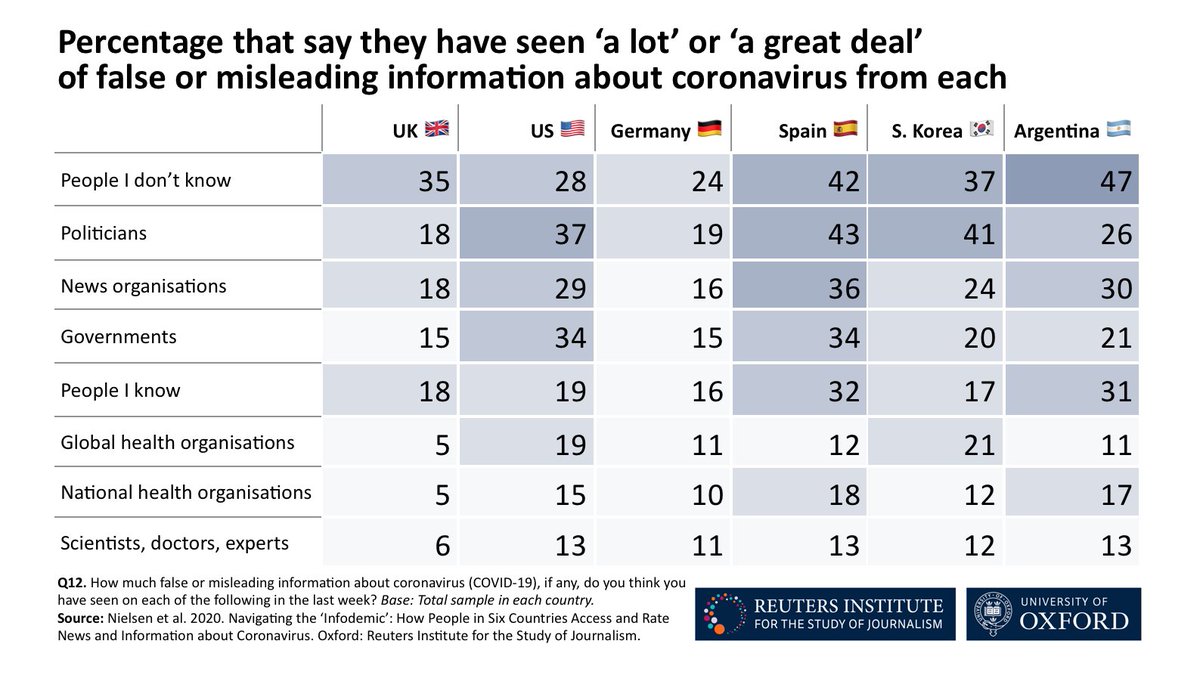 https://abs.twimg.com/emoji/v2/... draggable="false" alt="🇺🇸" title="Flag of United States" aria-label="Emoji: Flag of United States">https://abs.twimg.com/emoji/v2/... draggable="false" alt="🇪🇸" title="Flag of Spain" aria-label="Emoji: Flag of Spain"> say individual politicians generate large volumes of top-down misinformation" title="9. Concern about misinformation is focused on & #39;bottom-up& #39; false or misleading content spread by ordinary people whom respondents do not know personally. However, respondents in https://abs.twimg.com/emoji/v2/... draggable="false" alt="🇰🇷" title="Flag of South Korea" aria-label="Emoji: Flag of South Korea">https://abs.twimg.com/emoji/v2/... draggable="false" alt="🇺🇸" title="Flag of United States" aria-label="Emoji: Flag of United States">https://abs.twimg.com/emoji/v2/... draggable="false" alt="🇪🇸" title="Flag of Spain" aria-label="Emoji: Flag of Spain"> say individual politicians generate large volumes of top-down misinformation" class="img-responsive" style="max-width:100%;"/>
https://abs.twimg.com/emoji/v2/... draggable="false" alt="🇺🇸" title="Flag of United States" aria-label="Emoji: Flag of United States">https://abs.twimg.com/emoji/v2/... draggable="false" alt="🇪🇸" title="Flag of Spain" aria-label="Emoji: Flag of Spain"> say individual politicians generate large volumes of top-down misinformation" title="9. Concern about misinformation is focused on & #39;bottom-up& #39; false or misleading content spread by ordinary people whom respondents do not know personally. However, respondents in https://abs.twimg.com/emoji/v2/... draggable="false" alt="🇰🇷" title="Flag of South Korea" aria-label="Emoji: Flag of South Korea">https://abs.twimg.com/emoji/v2/... draggable="false" alt="🇺🇸" title="Flag of United States" aria-label="Emoji: Flag of United States">https://abs.twimg.com/emoji/v2/... draggable="false" alt="🇪🇸" title="Flag of Spain" aria-label="Emoji: Flag of Spain"> say individual politicians generate large volumes of top-down misinformation" class="img-responsive" style="max-width:100%;"/>
 https://abs.twimg.com/emoji/v2/... draggable="false" alt="🇪🇸" title="Flag of Spain" aria-label="Emoji: Flag of Spain">" title="10. Among platforms, concern is focused on social media and messaging apps, where on average about a third of respondents say they have seen a lot or a great deal of false or misleading information in the last week. % for social and messaging apps are especially high in https://abs.twimg.com/emoji/v2/... draggable="false" alt="🇦🇷" title="Flag of Argentina" aria-label="Emoji: Flag of Argentina">https://abs.twimg.com/emoji/v2/... draggable="false" alt="🇪🇸" title="Flag of Spain" aria-label="Emoji: Flag of Spain">" class="img-responsive" style="max-width:100%;"/>
https://abs.twimg.com/emoji/v2/... draggable="false" alt="🇪🇸" title="Flag of Spain" aria-label="Emoji: Flag of Spain">" title="10. Among platforms, concern is focused on social media and messaging apps, where on average about a third of respondents say they have seen a lot or a great deal of false or misleading information in the last week. % for social and messaging apps are especially high in https://abs.twimg.com/emoji/v2/... draggable="false" alt="🇦🇷" title="Flag of Argentina" aria-label="Emoji: Flag of Argentina">https://abs.twimg.com/emoji/v2/... draggable="false" alt="🇪🇸" title="Flag of Spain" aria-label="Emoji: Flag of Spain">" class="img-responsive" style="max-width:100%;"/>
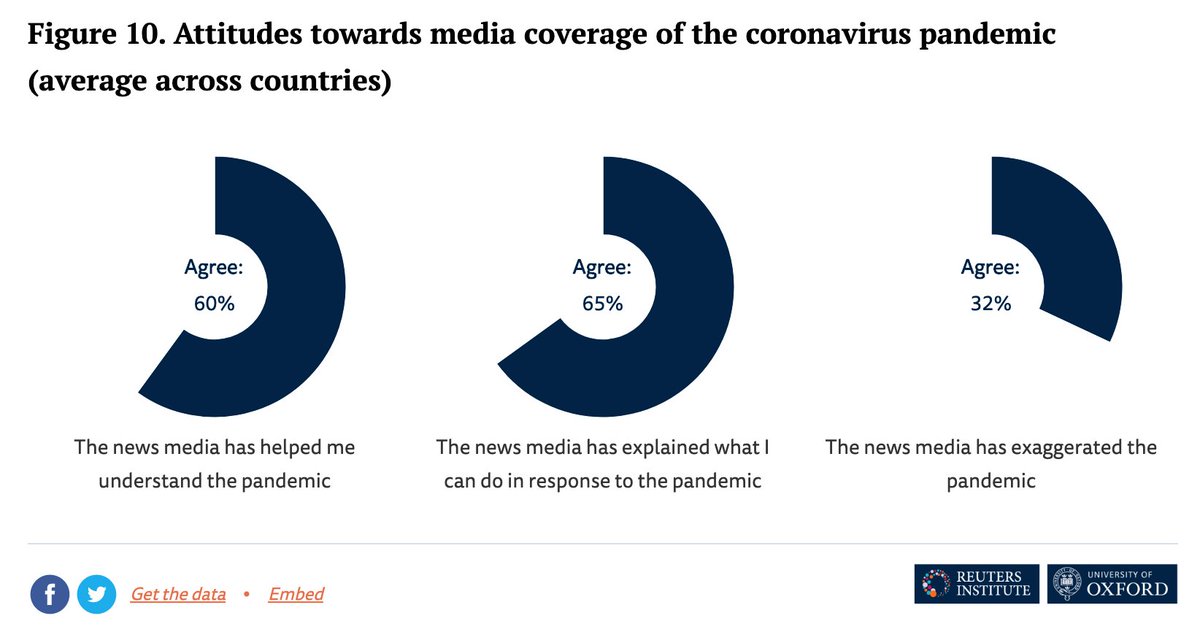 Governments, on average, rated less well than news organisations in helping people understand the crisis" title="11. Overall, a large majority of our respondents say they feel news media have helped them understand the crisis and have explained how they can respond to it. https://abs.twimg.com/emoji/v2/... draggable="false" alt="🏛" title="Classical building" aria-label="Emoji: Classical building">Governments, on average, rated less well than news organisations in helping people understand the crisis" class="img-responsive" style="max-width:100%;"/>
Governments, on average, rated less well than news organisations in helping people understand the crisis" title="11. Overall, a large majority of our respondents say they feel news media have helped them understand the crisis and have explained how they can respond to it. https://abs.twimg.com/emoji/v2/... draggable="false" alt="🏛" title="Classical building" aria-label="Emoji: Classical building">Governments, on average, rated less well than news organisations in helping people understand the crisis" class="img-responsive" style="max-width:100%;"/>
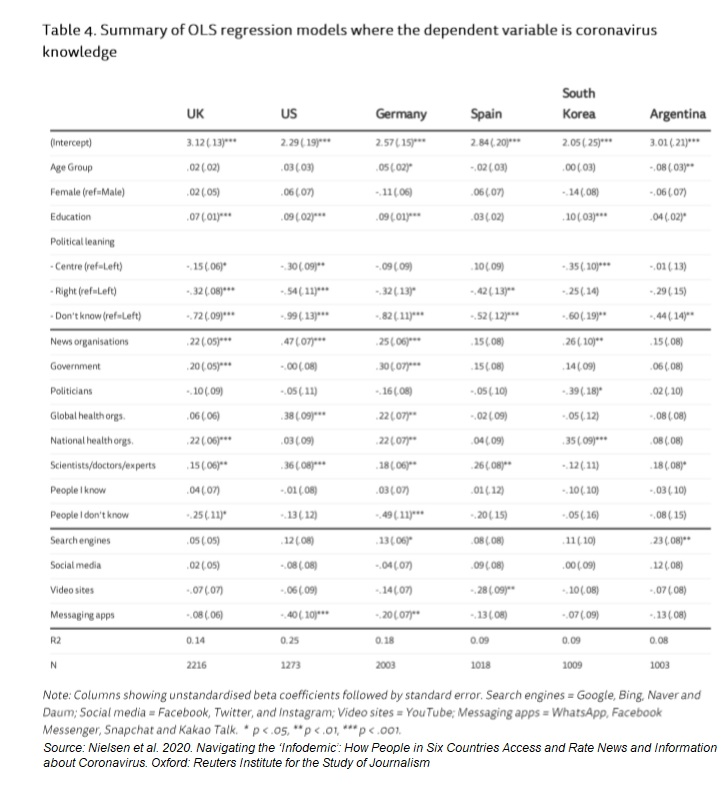 https://abs.twimg.com/emoji/v2/... draggable="false" alt="🇦🇷" title="Flag of Argentina" aria-label="Emoji: Flag of Argentina">)" title="12. Most people do relatively well when asked a series of factual questions about coronavirus, with a clear majority answering more than half the questions correctly. Using news orgs as source of info is associated with higher knowledge in most countries (not in https://abs.twimg.com/emoji/v2/... draggable="false" alt="🇪🇸" title="Flag of Spain" aria-label="Emoji: Flag of Spain">https://abs.twimg.com/emoji/v2/... draggable="false" alt="🇦🇷" title="Flag of Argentina" aria-label="Emoji: Flag of Argentina">)" class="img-responsive" style="max-width:100%;"/>
https://abs.twimg.com/emoji/v2/... draggable="false" alt="🇦🇷" title="Flag of Argentina" aria-label="Emoji: Flag of Argentina">)" title="12. Most people do relatively well when asked a series of factual questions about coronavirus, with a clear majority answering more than half the questions correctly. Using news orgs as source of info is associated with higher knowledge in most countries (not in https://abs.twimg.com/emoji/v2/... draggable="false" alt="🇪🇸" title="Flag of Spain" aria-label="Emoji: Flag of Spain">https://abs.twimg.com/emoji/v2/... draggable="false" alt="🇦🇷" title="Flag of Argentina" aria-label="Emoji: Flag of Argentina">)" class="img-responsive" style="max-width:100%;"/>


